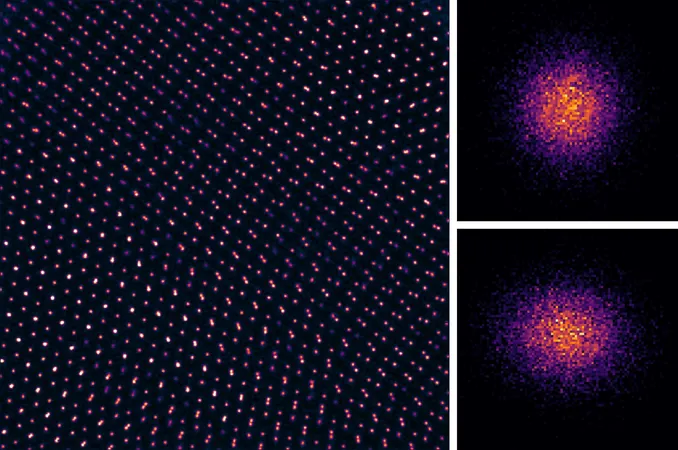
Unlocking the Secrets of Cold-Climate Proteins: The Future of Brain-Cell Control
2025-07-04
Author: Rajesh
Picture the awe-inspiring glaciers of Greenland and the icy peaks of the Tibetan Highlands. While these stunning natural wonders captivate the eye, for researcher Kirill Kovalev, they hide astonishing molecules that could revolutionize the way we control brain cells.
The Fascination with Rhodopsins
Kovalev, a postdoctoral fellow at EMBL Hamburg, has dedicated his career to uncovering the mysteries of rhodopsins, colorful proteins that allow aquatic microorganisms to transform sunlight into energy. "I scour for unusual rhodopsins to discover their hidden functions," he says. These proteins have already been harnessed for optogenetics, allowing scientists to manipulate neuronal activities through light.
The Discovery of Cryorhodopsins
For years, Kovalev believed he understood rhodopsins completely—until he stumbled upon a bizarre family of these proteins, dubbed cryorhodopsins, found exclusively in extreme cold environments. His unexpected find arose while exploring protein databases, revealing identical structures from organisms thousands of kilometers apart.
A Chromatic Revelation
Intrigued, Kovalev delved deeper into the aesthetics of these proteins. Most rhodopsins showcase a pink-orange hue, reflecting specific light wavelengths. However, his examinations unveiled a stunning array of colors, including a peculiar blue. The breakthrough, published in Science Advances, suggests that the molecular structure determines the rhodopsin's color, paving the way for synthetic blue variants tailored for various applications.
Pioneering New Optogenetic Tools
When these cryorhodopsins were tested in brain cell cultures, remarkable patterns were observed. Under UV light, they triggered electrical currents inside the cells. Interestingly, switching to green light heightened cell excitability, while using UV or red light dampened it. "Imagine the potential for new optogenetic tools—switching a cell's activity on and off could transform biotechnology and medicine!" says Tobias Moser from University Medical Center Göttingen.
Unraveling the Proteins’ Dual Function
What makes these cryorhodopsins even more intriguing is their ability to sense UV light, thanks to their slow response time. Collaborating with scientists from Goethe University Frankfurt, Kovalev theorizes that these proteins help microbes detect harmful UV exposure, an invaluable survival tool in icy climates.
FROM LAB TO APPLICATIONS
Despite their current experimental stage, Kovalev believes these proteins could serve as powerful prototypes. The next challenge lies in perfecting their application for future use in medical advancements, including optical cochlear implants aimed at restoring hearing.
Scientific Exploration: Key to Discovery
Kovalev emphasizes the significance of scientific exploration to uncover these remarkable molecules. Studies of organisms in their native, extreme environments enhance our understanding of how life adapts, offering a wellspring of potential breakthroughs for humanity.
Overcoming Technical Barriers
Studying cryorhodopsins comes with its set of hurdles. Their near-identical structures demand advanced techniques such as 4D structural biology, which combines X-ray crystallography and cryo-electron microscopy, allowing for detailed insights into their properties. Kovalev's choice to work at EMBL Hamburg was influenced by its cutting-edge research facilities, which enabled him to embark on this groundbreaking project.
In a world where understanding life at the molecular level can lead to transformative applications, the discovery of cryorhodopsins represents just the tip of the iceberg. Their potential to influence brain cell activity and beyond could pave the way for a new era of medical technologies.



 Brasil (PT)
Brasil (PT)
 Canada (EN)
Canada (EN)
 Chile (ES)
Chile (ES)
 Česko (CS)
Česko (CS)
 대한민국 (KO)
대한민국 (KO)
 España (ES)
España (ES)
 France (FR)
France (FR)
 Hong Kong (EN)
Hong Kong (EN)
 Italia (IT)
Italia (IT)
 日本 (JA)
日本 (JA)
 Magyarország (HU)
Magyarország (HU)
 Norge (NO)
Norge (NO)
 Polska (PL)
Polska (PL)
 Schweiz (DE)
Schweiz (DE)
 Singapore (EN)
Singapore (EN)
 Sverige (SV)
Sverige (SV)
 Suomi (FI)
Suomi (FI)
 Türkiye (TR)
Türkiye (TR)
 الإمارات العربية المتحدة (AR)
الإمارات العربية المتحدة (AR)